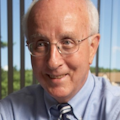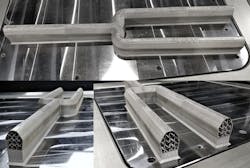Laser additive manufacturing targets larger stainless steel components
Additive manufacturing technologies are increasingly allowing the manufacturing of parts with geometries not achievable. In the case of laser powder-bed fusion (LPBF) technology, the SLM-XL project has taken the parts-size shortcoming and produced large 316L stainless steel parts over 1 m.
The project included the development of a prototype machine for larger parts using LPBF technology with a breakthrough technology, tiled laser melting (TLM), that is paving the way for the seamless production of small to large parts for the most demanding usage scenarios. Printing large-scaled parts with LPBF provides a fast and efficient way to create low-volume parts of any length and height, allowing flexibility in design and overcoming disadvantages of traditional manufacturing technologies.
The project has produced samples on the customized LPBF machine with relative densities above 99%, with the best result at 99.655%. This is a positive indicator towards the ultimate goal of zero-defect additive manufacturing in producing large components with LPBF.
The SLM-XL project was led by equipment manufacturer Adira Metal Forming Solutions (Vila Nova de Gaia, Portugal), with the collaboration of research organizations Instituto Superior Técnico (Lisbon, Portugal), the Universidade Nova de Lisboa – Faculdade de Ciência e Tecnologia (Almada, Portugal), and the Institute of Science and Innovation in Mechanical and Industrial Engineering (INEGI; Porto, Portugal), as well as end user Manuel Conceição Graça (MCG; Carregado, Portugal).
This specific prototype includes a TLM printing process technology developed by Adira. To produce larger parts, the project brought the broad utilization of LPBF into the mainstream, with clear benefits in efficient resources utilization, cost-effectiveness for customized smaller production runs, and overall flexibility on the production. The project’s outcomes included a methodology for selection of parameters to fabricate large metal parts in stainless steel 316L, as well as contributing for the development of the final prototype machine.
Laser powder-bed fusion is a layer-by-layer process in which a defined powder thickness is melted by the laser, allowing the manufacture of functional complex-shaped objects with high structural integrity for low volume and affordable costs in different materials. Being able to deliver parts produced through this technology has already been used for biomedical devices. But ensuring the production of larger parts, retaining the expected features of materials made from traditional subtractive manufacturing, has proven elusive so far. By showing the capability of producing large build envelopes of 316L stainless steel samples, the project has paved the way for other materials to follow in the near future. To achieve the results of 99% plus density in all the part, it was required to adjust the parameters at the outer zones, and a methodology to perform this adjustment has also been proposed as an outcome of this project.
For more information, please visit adira.pt and aai.tecnico.ulisboa.pt.
Related Article
About the Author

David Belforte
Contributing Editor
David Belforte (1932-2023) was an internationally recognized authority on industrial laser materials processing and had been actively involved in this technology for more than 50 years. His consulting business, Belforte Associates, served clients interested in advanced manufacturing applications. David held degrees in Chemistry and Production Technology from Northeastern University (Boston, MA). As a researcher, he conducted basic studies in material synthesis for high-temperature applications and held increasingly important positions with companies involved with high-technology materials processing. He co-founded a company that introduced several firsts in advanced welding technology and equipment. David's career in lasers started with the commercialization of the first industrial solid-state laser and a compact CO2 laser for sheet-metal cutting. For several years, he led the development of very high power CO2 lasers for welding and surface treating applications. In addition to consulting, David was the Founder and Editor-in-Chief of Industrial Laser Solutions magazine (1986-2022) and contributed to other laser publications, including Laser Focus World. He retired from Laser Focus World in late June 2022.
